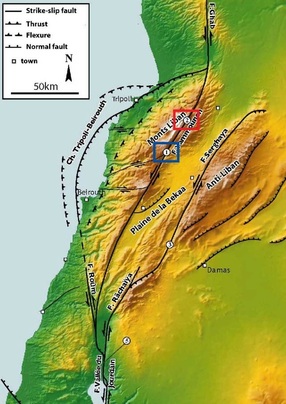Strike-slip fault kinematics > Paleo-earthquakes on the Yammouneh fault, central Dead Sea fault
|
Objectives, approach and main results:
The long-term goal of this project is to characterize the paleo-earthquake sequence along the Yammouneh fault, the main strike-slip fault segment of the Dead Sea fault system in Lebanon. Excavation of paleoseismological trenches at several sites along the fault help determine local paleo-earthquakes occurrence. By comparing the earthquake sequences from each site, we hope to be able to estimate the paleo-rupture length, identify potential barriers to rupture propagation and observe how fault segments interact with each other. A first trench has been investigated at one location, the Yammouneh basin, by Daëron et al [2007]. Our work focuses on a second trench, opened in a basin located 30 km north. At least 17 events were identified in the trench. A first-order chronology based on luminescence dating provided older ages from 26 ka at 0.5 m depth to 30 ka at 3.7 m depth. We obtain a much shorter average recurrence interval at our study site compared to Daëron et al study. We discussed the possible implications of this difference for the seismic behavior of the fault. Eventually, we favor the stratigraphic resolution of the trenches as the main parameter to affect the earthquake record: the mm to cm thick layers at our site would allow recording small deformations related to smaller-magnitude events that may have been missed in the rougher strata of Daëron et al site. |
>> Read more:
* Le Beon, M., Y.-C. Tseng, Y. Klinger, A. Elias, A. Kunz, A. Sursock, M. Daeron, P. Tapponnier, and R. Jomaa (2018), High-resolution stratigraphy and multiple luminescence dating techniques to reveal the paleoseismic history of the central Dead Sea fault (Yammouneh fault, Lebanon), Tectonophysics, 738-739, 1-15, https://doi.org/10.1016/j.tecto.2018.04.009
* Le Beon, M., Y.-C. Tseng, Y. Klinger, A. Elias, A. Kunz, A. Sursock, M. Daeron, P. Tapponnier, and R. Jomaa (2018), High-resolution stratigraphy and multiple luminescence dating techniques to reveal the paleoseismic history of the central Dead Sea fault (Yammouneh fault, Lebanon), Tectonophysics, 738-739, 1-15, https://doi.org/10.1016/j.tecto.2018.04.009

